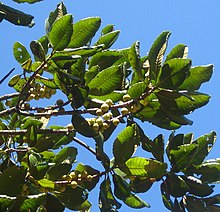Uapaca kirkiana
| Uapaca kirkiana | |
|---|---|

| |
| Scientific classification | |
| Kingdom: | Plantae |
| Clade: | Tracheophytes |
| Clade: | Angiosperms |
| Clade: | Eudicots |
| Clade: | Rosids |
| Order: | Malpighiales |
| Family: | Phyllanthaceae |
| Genus: | Uapaca |
| Species: | U. kirkiana
|
| Binomial name | |
| Uapaca kirkiana Müll. Arg. | |

| |
| approximate range | |
Uapaca kirkiana, the sugar plum or mahobohobo, is a species of
In
Range
It occurs in the miombo woodlands of Angola, the DRCongo, Zambia, southern Burundi, Tanzania, Malawi, central and northern Mozambique, and Zimbabwe.[2]
Growth
It is a
Fruit
Female trees fruit after about 9–10 years from seed. The fruit is roughly spherical drupe about 2–4 cm in diameter, green in colour ripening to yellow or brown. When ripe, the 1.5mm hard shell encloses the yellow flesh which has an appealing sweet taste that has been likened to pear or plum. Fruits usually contain 3 or 4 seeds, though sometimes 5. Fruits weigh between 5 and 50 grams each, with from 0.2 to 30 grams of pulp. The fruit is usually eaten by wild animals such as monkeys.
Propagation
It is usually propagated by seed, which is recalcitrant and germinates readily, reaching 90% after 6 weeks for fresh seed. The tree can also be propagated vegetatively – a success rate of 80% has been achieved with wedge or splice grafts. Air layering is also possible, though these trees have not fared well without a taproot. The tree naturally propagates via underground suckers and forms stands.
Cultivars
Little work has been done developing cultivars, though some named varieties do exist. Since 1996, work on propagating of superior seedlings has been carried out in Malawi, Tanzania, Zambia, Mozambique and Zimbabwe by the Southern Africa Regional Programme.[3]
Name
The species is named in honor of Sir John Kirk, explorer and naturalist (1832-1922).[4]
References
- ISBN 978-0-309-10596-5. Retrieved 2008-08-01.
- JSTOR 43582058.
- ISBN 978-1-84593-110-0, retrieved 2023-06-07
- ^ Orwa C, A Mutua, Kindt R , Jamnadass R, S Anthony. 2009 Agroforestree Database:a tree reference and selection guide version 4.0 (http://www.worldagroforestry.org/sites/treedbs/treedatabases.asp)
